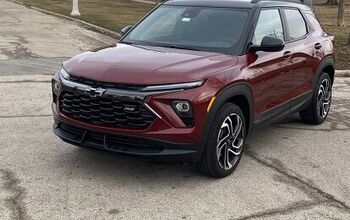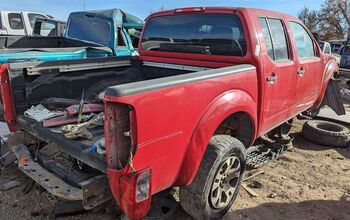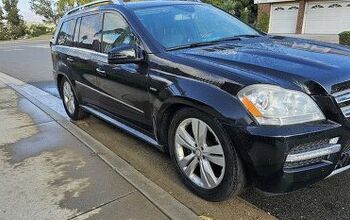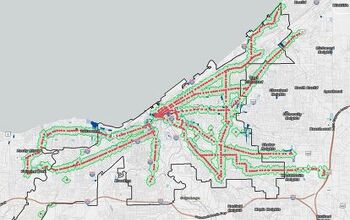Annoy the Driver: IIHS Says Seatbelt Chimes Aren't Loud Enough

The Insurance Institute for Highway Safety (IIHS) has spent the last few years branching out from crash tests to focus on some of the safety tech in modern vehicles. However, this arguably peaked when the group realized that modern vehicles with higher ride heights were blinding everyone with their headlights and decided that might be something worth including in general safety testing. The IIHS has since preoccupied itself with advocating for additional electronic nannies and mimicking government regulators by suggesting vehicles should annoy drivers as often as possible.
This week, that manifested by way of the IIHS upgrading its safety program to include pressuring manufacturers into making seat belt reminders more irritating. While the federal standards specify that undone belts must include an audible signal that lasts between four and eight seconds, in conjunction with a minute-long warning light, the non-profit (supported by insurance companies) believes reminders should be longer and louder than outlined by existing requirements.
“By now everybody knows that seat belts save lives when they are used,” says IIHS President David Harkey. “Our research shows that effective seat belt reminders can also save lives by getting those who aren’t diligent about belt use to buckle up. These new ratings are designed to push manufacturers to realize that potential.”
“Most Americans use their seat belts, especially in the front seat. But the small number who don’t translates into a lot of fatalities,” he continued. “Almost half of the drivers and front seat passengers killed in crashes in 2019 weren’t belted.”
That’s a shame. But, as Harkey stated, everybody knows that seat belts save lives when they are used. Nationally mandated in 1968, the widespread implementation of seat belts is frequently attributed to a decline in roadway fatalities between 1970 and 1975. But per capita deaths actually pitched up again until the 1980s, followed by several decades of gradual declines. Americans living today currently experience less than half the car-based fatalities (based on population) they would have in the late 1960s.
While seat belts undoubtedly played an important factor, so did things like crumple zones, airbags, modern tires, and the nation collectively deciding to de-normalize drunk driving. Though it’s worth noting that the push to discourage inebriation started in the early 1900s and took decades to reach that kind of impact, mimicking the long slow journey of widespread belt use before real improvements manifested.
The IIHS is taking a less nuanced approach, confident that upping the ante on warning chimes will be sufficient in preventing 1,500 fewer deaths per year by convincing 34 percent of individuals who don’t buckle up to finally do so. This is based on an earlier study conducted by the group, in conjunction with the Highway Loss Data Institute (HLDI), that attempted to determine whether bringing back interlocking devices would be superior to seat-belt reminders.
“We expected the interlocks to be more effective than any type of belt reminder, but that didn’t turn out to be the case,” HLDI Senior Research Scientist David Kidd explained. “Many people simply forget to buckle up, so a persistent reminder works well for them. For those who are really averse to using the seat belt, an interlock doesn’t always help because they can find a way to get around it, for example by buckling the belt behind their back or sitting on top of it.”
These are ill-advised strategies. But we’ve probably all seen someone do it to circumvent having to wear a safety belt. Despite the National Highway Traffic Safety Administration (NHTSA) suggesting that automakers could install immobilizers based on harness use in 2021, the IIHS-HLDI feels louder/longer chimes would be a better solution. Though your author would be surprised to see either solution make a meaningful difference in crash data considering the United States seat-belt compliance rate is already at an all-time high.
Most automakers also go well beyond the federal minimum in terms of how pervasive their warning chimes have to be. But the Insurance Institute for Highway Safety still doesn’t believe they’re going far enough and compared several models to showcase the differences, before rolling it into its revised testing standards.
From the IIHS:
To encourage manufacturers to adopt more effective and consistent standards, the new IIHS protocol rates seat belt reminders as good, acceptable, marginal or poor, based primarily on the volume, duration and timing of the audible alert.
To earn a good rating, a seat belt reminder system must generate an audible signal and visual alert on the dashboard display, overhead panel or center console when the vehicle is moving at least 6 mph and the system detects an unbelted occupant in one of the front-row seating positions or the unfastening of a second-row belt that was previously buckled.
Along with other specifications, the audible alert must be loud enough to be heard over the background noise in the vehicle cabin. If the seat belt of an occupied front-row seat remains unbuckled, the visual and audible reminders must last at least 90 seconds. If a previously fastened second-row belt is unbuckled, the reminders must last at least 30 seconds. A visual indicator that appears when the driver starts the vehicle is also required for the second row.
Vehicles that meet all the requirements for the front row but miss any or all of the requirements for the second row earn an acceptable rating. Vehicles that miss any or all of the front row requirements but include an audible alert that is eight seconds or longer for both the driver and front seat passenger earn a marginal rating. Vehicles with reminders that are shorter than eight seconds earn a poor rating, whether or not they meet any of the other criteria.
“The gold standard is an alert that’s impossible to ignore,” stated IIHS Senior Test Coordinator Sean O’Malley.
“Most of these problems don’t require new hardware,” he continued. “Even among the vehicles that earn poor ratings, it’s possible that simply lengthening the duration of the audible alert could do the trick.”
While your author is all for improved automotive safety, this doesn’t seem like the best use of the IIHS’ time. There’s been a growing trend among regulators and trade organizations of late to adopt electronic nannies designed to condition drivers like Pavlov’s dogs. However, this appears to be coming at the expense of encouraging meaningful improvements to the functionality of advanced driving aids, vehicle construction, or removing all the distracting equipment that keeps a motorist’s eyes off the road ahead.
If you want to see how the handful of smallish vehicles the IIHS initially tested compared, you’ll have to check out its website. Though the obvious takeaway is that scoring came down to how obnoxious individual manufacturers opted to make their warning sounds (giving Subaru top honors). Longer and louder always yielded a better grade, with the inclusion of warnings for the second row (handy if you have a few kids) being required for the best ratings. If that’s important to you, then there’s now a resource to use. But some of us are having trouble envisioning how this is will actually change the minds of people who have been successfully ignoring seatbelt reminders for years and wonder if it’s not a distraction from some of the more-important issues taking place within the industry today.
[Image: Pamela Au/Shutterstock]

A staunch consumer advocate tracking industry trends and regulation. Before joining TTAC, Matt spent a decade working for marketing and research firms based in NYC. Clients included several of the world’s largest automakers, global tire brands, and aftermarket part suppliers. Dissatisfied with the corporate world and resentful of having to wear suits everyday, he pivoted to writing about cars. Since then, that man has become an ardent supporter of the right-to-repair movement, been interviewed on the auto industry by national radio broadcasts, driven more rental cars than anyone ever should, participated in amateur rallying events, and received the requisite minimum training as sanctioned by the SCCA. Handy with a wrench, Matt grew up surrounded by Detroit auto workers and managed to get a pizza delivery job before he was legally eligible. He later found himself driving box trucks through Manhattan, guaranteeing future sympathy for actual truckers. He continues to conduct research pertaining to the automotive sector as an independent contractor and has since moved back to his native Michigan, closer to where the cars are born. A contrarian, Matt claims to prefer understeer — stating that front and all-wheel drive vehicles cater best to his driving style.
More by Matt Posky
Latest Car Reviews
Read moreLatest Product Reviews
Read moreRecent Comments
- Alan As the established auto manufacturers become better at producing EVs I think Tesla will lay off more workers.In 2019 Tesla held 81% of the US EV market. 2023 it has dwindled to 54% of the US market. If this trend continues Tesla will definitely downsize more.There is one thing that the established auto manufacturers do better than Tesla. That is generate new models. Tesla seems unable to refresh its lineup quick enough against competition. Sort of like why did Sears go broke? Sears was the mail order king, one would think it would of been easier to transition to online sales. Sears couldn't adapt to on line shopping competitively, so Amazon killed it.
- Alan I wonder if China has Great Wall condos?
- Alan This is one Toyota that I thought was attractive and stylish since I was a teenager. I don't like how the muffler is positioned.
- ToolGuy The only way this makes sense to me (still looking) is if it is tied to the realization that they have a capital issue (cash crunch) which is getting in the way of their plans.
- Jeff I do think this is a good thing. Teaching salespeople how to interact with the customer and teaching them some of the features and technical stuff of the vehicles is important.


































Comments
Join the conversation
“Most Americans use their seat belts, especially in the front seat. But the small number who don’t translates into a lot of fatalities,” he continued. “Almost half of the drivers and front seat passengers killed in crashes in 2019 weren’t belted.” Darwin. He seems to take care of those problems.
just verify that seatbelt was unlatched during crash & permit ins. cos. to deny coverage. Rates would go down 50%